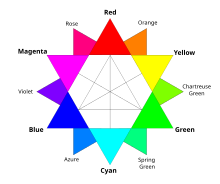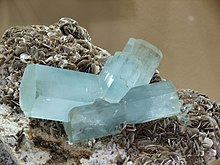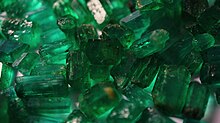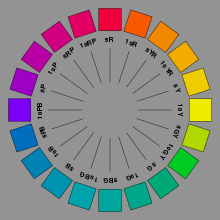
A | B | C | D | E | F | G | H | CH | I | J | K | L | M | N | O | P | Q | R | S | T | U | V | W | X | Y | Z | 0 | 1 | 2 | 3 | 4 | 5 | 6 | 7 | 8 | 9
This article has multiple issues. Please help improve it or discuss these issues on the talk page. (Learn how and when to remove these template messages)
|
| Spring green | |
|---|---|
| Hex triplet | #00FF80 |
| sRGBB (r, g, b) | (0, 255, 128) |
| HSV (h, s, v) | (150°, 100%, 100%) |
| CIELChuv (L, C, h) | (88, 109, 137°) |
| Source | RGB and CMYK color systems. The colour halfway between green and cyan on the RGB color wheel has a hex code of 00FF80. |
| B: Normalized to (byte) H: Normalized to (hundred) | |

Spring green is a color that was traditionally considered to be on the yellow side of green, but in modern computer systems based on the RGB color model is halfway between cyan and green on the color wheel.
The modern spring green, when plotted on the CIE chromaticity diagram, corresponds to a visual stimulus of about 505 nanometers on the visible spectrum. In HSV color space, the expression of which is known as the RGB color wheel, spring green has a hue of 150°. Spring green is one of the tertiary colors on the RGB color wheel, where it is the complementary color of rose.
The first recorded use of spring green as a color name in English was in 1766, referring to roughly the color now called spring bud.[1]
Spring green (computer)
Spring green (HTML)
| Spring green | |
|---|---|
| Hex triplet | #00FF7F |
| sRGBB (r, g, b) | (0, 255, 127) |
| HSV (h, s, v) | (150°, 100%, 100%) |
| CIELChuv (L, C, h) | (88, 110, 137°) |
| Source | X11 |
| ISCC–NBS descriptor | Vivid bluish green |
| B: Normalized to (byte) | |
Spring green is a web color, common to X11 and HTML.
Medium spring green
| Medium spring green | |
|---|---|
| Hex triplet | #00FA9A |
| sRGBB (r, g, b) | (0, 250, 154) |
| HSV (h, s, v) | (157°, 100%, 98%) |
| CIELChuv (L, C, h) | (87, 95, 143°) |
| Source | X11[2] |
| ISCC–NBS descriptor | Vivid yellowish green |
| B: Normalized to (byte) | |
Displayed at right is the color medium spring green.
Medium spring green is a web color. It is close to but not right on the color wheel and it is a little closer to cyan than to green.
Dark spring green
| Dark spring green | |
|---|---|
| Hex triplet | #177245 |
| sRGBB (r, g, b) | (23, 114, 69) |
| HSV (h, s, v) | (150°, 80%, 45%) |
| CIELChuv (L, C, h) | (42, 43, 142°) |
| Source | X11 |
| ISCC–NBS descriptor | Deep yellowish green |
| B: Normalized to (byte) | |
At right is displayed the web color dark spring green.
Additional variations of web spring green
Mint cream
| Mint cream | |
|---|---|
| Hex triplet | #F5FFFA |
| sRGBB (r, g, b) | (245, 255, 250) |
| HSV (h, s, v) | (150°, 4%, 100%) |
| CIELChuv (L, C, h) | (99, 6, 153°) |
| Source | X11 |
| ISCC–NBS descriptor | Very pale green |
| B: Normalized to (byte) | |
Displayed at right is the web color mint cream, a pale pastel tint of spring green.
The color mint cream is a representation of the color of the interior of an after dinner mint (which is disc shaped with mint flavored buttercream on the inside and a chocolate coating on the outside).
Sea green
| Sea green | |
|---|---|
| Hex triplet | #2E8B57 |
| sRGBB (r, g, b) | (46, 139, 87) |
| HSV (h, s, v) | (146°, 67%, 55%) |
| CIELChuv (L, C, h) | (52, 50, 141°) |
| Source | HTML/CSS |
| ISCC–NBS descriptor | Strong yellowish green |
| B: Normalized to (byte) | |


Sea green is a shade of cyan color that resembles the hue of shallow seawater as seen from the surface.
Sea green is notable for being the emblematic color of the Levellers party in the politics of 1640s England. Leveller supporters would wear a sea-green ribbon, in a similar manner to the present-day red AIDS awareness ribbon.
Medium sea green
| Medium sea green | |
|---|---|
| Hex triplet | #3CB371 |
| sRGBB (r, g, b) | (60, 179, 113) |
| HSV (h, s, v) | (147°, 66%, 70%) |
| CIELChuv (L, C, h) | (65, 64, 141°) |
| Source | X11 |
| ISCC–NBS descriptor | Strong yellowish green |
| B: Normalized to (byte) | |
At right is displayed the web color medium sea green, a medium shade of spring green.
Aquamarine
| Aquamarine | |
|---|---|
| Hex triplet | #7FFFD4 |
| sRGBB (r, g, b) | (127, 255, 212) |
| HSV (h, s, v) | (160°, 50%, 100%) |
| CIELChuv (L, C, h) | (92, 60, 158°) |
| Source | X11 |
| ISCC–NBS descriptor | Brilliant green |
| B: Normalized to (byte) | |

Aquamarine is a color that is a pale bright tint of spring green toned toward cyan. It represents the color of the aquamarine gemstone. Aquamarine is the birthstone for those born on January 21 to February 20 in tropical zodiac, and February 14 to March 15 in sidereal zodiac.
Spring green (traditional)
Spring bud
| Spring Bud | |
|---|---|
| Hex triplet | #A7FC00 |
| sRGBB (r, g, b) | (167, 252, 0) |
| HSV (h, s, v) | (80°, 100%, 99%) |
| CIELChuv (L, C, h) | (91, 114, 112°) |
| Source | Maerz and Paul[3] |
| ISCC–NBS descriptor | Vivid yellow green |
| B: Normalized to (byte) | |
Spring bud is the color that used to be called spring green before the X11 web color spring green was formulated in 1987 when the X11 colors were first promulgated. This color is now called spring bud to avoid confusion with the web color.[citation needed]
The color is also called soft spring green, spring green (traditional), or spring green (M&P).
The first recorded use of spring green as a color name in English (meaning the color that is now called spring bud) was in 1766.[4]
Additional variations of traditional spring green
Emerald
| Emerald | |
|---|---|
| Hex triplet | #50C878 |
| sRGBB (r, g, b) | (80, 200, 120) |
| HSV (h, s, v) | (140°, 60%, 78%) |
| CIELChuv (L, C, h) | (72, 71, 137°) |
| Source | Maerz and Paul[5] |
| ISCC–NBS descriptor | Vivid yellowish green |
| B: Normalized to 0–255 (byte) | |


green
|
emerald
|
viridian
|
Emerald, also called emerald green, is a tone of green that is particularly light and bright, with a faint bluish cast. The name derives from the typical appearance of the emerald gemstone.[6]
The first recorded use of emerald as a color name in English was in 1598.[7] Ireland is sometimes referred to as the Emerald Isle due to its lush greenery. The May birthstone is emerald. Seattle is sometimes referred to as the Emerald City, because its abundant rainfall creates lush vegetation. In the Middle Ages, The Emerald Tablet of Hermes Trismegistus was believed to contain the secrets of alchemy. "Emerald City", from the story of The Wonderful Wizard of Oz, by L. Frank Baum, is a city where everything from food to people are emerald green. However, it is revealed at the end of the story that everything in the city is normal colored, but the glasses everyone wears are emerald tinted. The Green Zone in Baghdad is sometimes ironically and cynically referred to as the Emerald City.[8] The Emerald Buddha is a figurine of the sitting Buddha, made of green jade (rather than emerald), clothed in gold, and about 45 cm tall. It is kept in the Chapel of the Emerald Buddha (Wat Phra Kaew) on the grounds of the Grand Palace in Bangkok. The Emerald Triangle refers to the three counties of Mendocino, Humboldt, and Trinity in Northern California, United States[9] because these three counties are the biggest marijuana producing counties in California and also the US.[9] A county-commissioned study reports pot accounts for up to two-thirds of the economy of Mendocino.[9] Emerald Cities: Urban Sustainability and Economic Development is a book published in 2010 by Joan Fitzgerald, director of the law, policy and society program at Northeastern University, about ecologically sustainable city planning.
Emerald was invented in Germany in 1814. By taking acetic acid, mixing and boiling it with vinegar, and then by adding some arsenic, a bright blue-green hue was formed.[10] During the 19th century, the arsenic-containing dye Paris green was marketed as emerald green.[11] It was notorious for causing deaths due to it being a popular color used for wallpaper. Victorian women used this bright color for dresses, and florists used it on fake flowers.[12]
Viridianedit
| Viridian | |
|---|---|
| Hex triplet | #40826D |
| sRGBB (r, g, b) | (64, 130, 109) |
| HSV (h, s, v) | (161°, 51%, 51%) |
| CIELChuv (L, C, h) | (50, 31, 160°) |
| Source | Maerz and Paul[13] |
| ISCC–NBS descriptor | Moderate green |
| B: Normalized to 0–255 (byte) | |
green
|
viridian
|
teal
|
At right is displayed the color viridian, a medium tone of spring green.
The first recorded use of viridian as a color name in English was in the 1860s (exact year uncertain).[14]
Other variations of spring greenedit
Green (CMYK) (pigment green)edit
| Green (CMYK) (pigment green) | |
|---|---|
| Hex triplet | #00A550 |
| sRGBB (r, g, b) | (0, 165, 80) |
| HSV (h, s, v) | (149°, 100%, 65%) |
| CIELChuv (L, C, h) | (59, 74, 137°) |
| Source | CMYK[15] |
| ISCC–NBS descriptor | Vivid yellowish green |
| B: Normalized to 0–255 (byte) | |
The color defined as green in the CMYK color system used in printing, also known as pigment green, is the tone of green that is achieved by mixing process (printer's) cyan and process (printer's) yellow in equal proportions. It is displayed at adjacent.

The purpose of the CMYK color system is to provide the maximum possible gamut of color reproducible in printing.
The color indicated is only approximate as the colors of printing inks may vary.
Green (NCS) (psychological primary green)edit
| Green (NCS) | |
|---|---|
| Hex triplet | #009F6B |
| sRGBB (r, g, b) | (0, 159, 107) |
| HSV (h, s, v) | (160°, 100%, 62%) |
| CIELChuv (L, C, h) | (58, 58, 148°) |
| Source | sRGB approximation to NCS 2060-G[16] |
| ISCC–NBS descriptor | Strong yellowish green |
| B: Normalized to 0–255 (byte) | |
The color defined as green in the NCS or Natural Color System is shown at adjacent (NCS 2060-G). The natural color system is a color system based on the four unique hues or psychological primary colors red, yellow, green, and blue. The NCS is based on the opponent process theory of vision.

The Natural Color System is widely used in Scandinavia.
Green (Munsell)edit
| Green (Munsell) | |
|---|---|
| Hex triplet | #00A877 |
| sRGBB (r, g, b) | (0, 168, 119) |
| HSV (h, s, v) | (162°, 100%, 66%) |
| CIELChuv (L, C, h) | (61, 59, 152°) |
| Source | Munsell Color Wheel[17] |
| ISCC–NBS descriptor | Brilliant green |
| B: Normalized to 0–255 (byte) | |
The color defined as green in the Munsell color system (Munsell 5G) is shown adjacent. The Munsell color system is a color space that specifies colors based on three color dimensions: hue, value (lightness), and chroma (color purity), spaced uniformly in three dimensions in the elongated oval at an angle shaped Munsell color solid according to the logarithmic scale which governs human perception. In order for all the colors to be spaced uniformly, it was found necessary to use a color wheel with five primary colors—red, yellow, green, blue, and purple.

The Munsell colors displayed are only approximate as they have been adjusted to fit into the sRGB gamut.
Green (Pantone)edit
| Green (Pantone) | |
|---|---|
| Hex triplet | #00AD83 |
| sRGBB (r, g, b) | (0, 173, 131) |
| HSV (h, s, v) | (165°, 100%, 68%) |
| CIELChuv (L, C, h) | (63, 58, 157°) |
| Source | Pantone TPX[18] |
| ISCC–NBS descriptor | Brilliant green |
| B: Normalized to 0–255 (byte) | |
Green (Pantone) is the color that is called green in Pantone.
The source of this color is the "Pantone Textile Paper eXtended (TPX)" color list, color # green C, EC, HC, PC, U, or UP—green.[18]
Green (Crayola)edit
| Green (Crayola) | |
|---|---|
| Hex triplet | #1CAC78 |
| sRGBB (r, g, b) | (28, 172, 120) |
| HSV (h, s, v) | (158°, 84%, 67%) |
| CIELChuv (L, C, h) | (63, 60, 149°) |
| Source | Crayola[citation needed] |
| ISCC–NBS descriptor | Strong yellowish green |
| B: Normalized to 0–255 (byte) | |
Green (Crayola) is the color called green in Crayola crayons.
Green was one of the original Crayola crayons introduced in 1903.
Erinedit
| Erin | |
|---|---|
| Hex triplet | #00FF40 |
| sRGBB (r, g, b) | (0, 255, 64) |
| HSV (h, s, v) | (135°, 100%, 100%) |
| CIELChuv (L, C, h) | (88, 129, 130°) |
| Source | Maerz and Paul[19] |
| ISCC–NBS descriptor | Vivid yellowish green |
| B: Normalized to 0–255 (byte) | |
Adjacent is displayed the color erin. The first recorded use of erin as a color name was in 1922.
Bright mintedit
| Bright mint | |
|---|---|
| Hex triplet | #4FFFB0 |
| sRGBB (r, g, b) | (79, 255, 176) |
| HSV (h, s, v) | (153°, 69%, 100%) |
| CIELChuv (L, C, h) | (90, 84, 146°) |
| Source | Unsourced |
| ISCC–NBS descriptor | Vivid yellowish green |
| B: Normalized to 0–255 (byte) | |
Displayed adjacent is the color bright mint.
Dark greenedit
| Dark green | |
|---|---|
| Hex triplet | #013220 |
| sRGBB (r, g, b) | (1, 50, 32) |
| HSV (h, s, v) | (158°, 98%, 20%) |
| CIELChuv (L, C, h) | (17, 17, 150°) |
| Source | Encycolorpedia[20] |
| ISCC–NBS descriptor | Very dark yellowish green |
| B: Normalized to 0–255 (byte) | |
Dark green is a dark shade of green. A different shade of green has been designated as "dark green (X11)" for certain computer uses.
Dark pastel greenedit
| Dark pastel green | |
|---|---|
| Hex triplet | #03C03C |
| sRGBB (r, g, b) | (3, 192, 60) |
| HSV (h, s, v) | (138°, 98%, 75%) |
| CIELChuv (L, C, h) | (68, 96, 131°) |
| Source | Encycolorpedia[21] |
| ISCC–NBS descriptor | Vivid yellowish green |
| B: Normalized to 0–255 (byte) | |
Text je dostupný za podmienok Creative Commons Attribution/Share-Alike License 3.0 Unported; prípadne za ďalších podmienok. Podrobnejšie informácie nájdete na stránke Podmienky použitia.
Antropológia
Aplikované vedy
Bibliometria
Dejiny vedy
Encyklopédie
Filozofia vedy
Forenzné vedy
Humanitné vedy
Knižničná veda
Kryogenika
Kryptológia
Kulturológia
Literárna veda
Medzidisciplinárne oblasti
Metódy kvantitatívnej analýzy
Metavedy
Metodika
Text je dostupný za podmienok Creative
Commons Attribution/Share-Alike License 3.0 Unported; prípadne za ďalších
podmienok.
Podrobnejšie informácie nájdete na stránke Podmienky
použitia.
www.astronomia.sk | www.biologia.sk | www.botanika.sk | www.dejiny.sk | www.economy.sk | www.elektrotechnika.sk | www.estetika.sk | www.farmakologia.sk | www.filozofia.sk | Fyzika | www.futurologia.sk | www.genetika.sk | www.chemia.sk | www.lingvistika.sk | www.politologia.sk | www.psychologia.sk | www.sexuologia.sk | www.sociologia.sk | www.veda.sk I www.zoologia.sk
